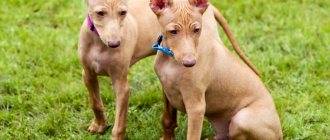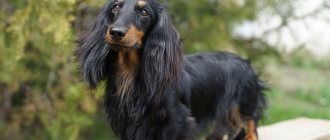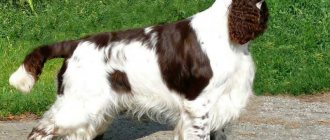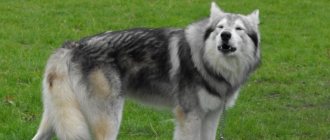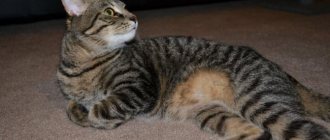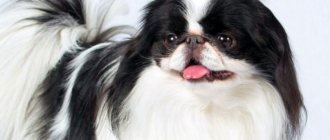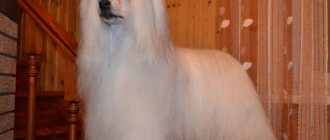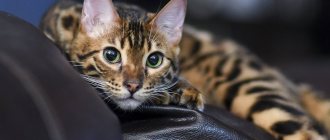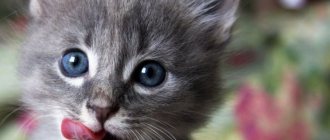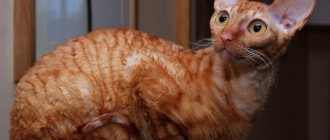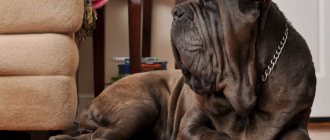These dogs are quite calm, very responsible and serious and do not bark just like that, without a reason. In addition, pets must be busy with something all the time so as not to get bored.
Origin story
The origins of the Bouvier des Flandres, like many other working breeds, can only be guessed at. It is believed that dogs of this type formed naturally in Flanders, but were “polished” by farmers who selected puppies based on their character and working qualities.
In the past, the Bouvier des Flanders had many names: cow dog, cow beater, dirty beard. The modern name Bouvier des Flanders appeared only in the 20th century.
Apparently, the ancestors of the Bouvier were large European shepherd dogs: Belgian Laekenois, Briard, Picardy Shepherd, as well as the Dutch Rough-haired. The formation of the Bouvier's appearance was probably also influenced by the climate of Flanders, which is characterized by high humidity and windiness. Until the beginning of the 20th century, no particular importance was attached to the exterior of dogs. In 1894, A. Reul, a professor at the Belgian veterinary school, who studied local shepherd dogs, identified five types, one was the so-called cow dog - the prototype of the modern Bouvier. Flemish shepherds were first shown at an exhibition in Brussels in 1910. A standard was developed in 1912. In an updated form, it was adopted in Belgium in 1923. In 1995, the Bouvier des Flandres (French Bouvier des Flandres) breed was officially recognized by the FCI and standard No. 191 was published.
Purpose
The Bouvier des Flandres is almost universal in terms of application. Initially it was used to work on the farm as a shepherd dog, a watchman and guard, an assistant during livestock drives, as a porter and traction force. During the First World War, it was used to transport the wounded from the battlefield and deliver various cargo. Today, the Bouvier is primarily a companion and family dog, a vigilant watchdog, guardian of territory, property or bodyguard. A keen sense of smell, a balanced character and good trainability allow the Bouvier to be used as a bloodhound for police work at customs. Suitable for shepherd service, but not as a cattle dog, but as a guard and escort who is also capable of finding lost cattle. Bouviers can be found in the ranks of guide dogs. Among other things, it is suitable for sports; the most suitable disciplines are agility, obedience, and canicross.
Video about the Bouvier Flandres dog breed (cow dog):
Historical reference
The Bouvier des Flandres dog is a working, herding dog that was not intentionally bred. On farms there is always a place for large four-legged animals performing security and court service. With the development of cattle breeding, the Bouvier of Flanders began to be actively used for grazing cattle and sheep.
The homeland of the breed is the territory of Belgium and France (formerly Flanders), with a climate suitable for raising livestock. However, in spacious meadows, where there is no protection from precipitation and wind, the working conditions are quite harsh. The Flanders Bouvier has evolved to keep up with the demands of farmers. The dog's coat became tougher, the undercoat was denser, even the beard and mustache served for protection. By the way, thanks to the rich vegetation on the face, one of the popular names for four-legged animals sounds like “dirty beard.”
This is interesting! The Bouvier of Flanders was actively used for some time to move cargo, but unlike draft dogs, the four-legged dogs carried luggage in baskets.
Despite the main version of the history of the breed, that the Bouvier of Flanders is an aborigine, there is a document stating that the four-legged animals were bred using selective breeding. In the 50s of the 20th century, a report was published containing evidence that representatives of the breed had lived in monasteries since the 12th century and were subject to deliberate selection. According to this version, the Bouvier of Flanders is not an indigenous breed, but a deliberately bred one . Dogs imported from England became the basis for breeding work.
This is interesting! The Flanders Bouvier, despite its rustic appearance, is actively used for work in the police and intelligence services.
The Bouvier des Flandres is a very hardy dog and has been used to its full potential . One or more four-legged animals lived on the farm, grazed, guarded, helped transport goods, and were busy working up to 18 hours a day. With the development of market (literally) trade, Bouviers of Flanders began to be used for transporting carcasses on carts.
Early individuals were noticeably different from modern dogs, with a great contrast in appearance. Modern representatives of the breed require a certain amount of care and grooming, while early dogs looked more like shaggy giants. Despite their power, the gene pool of the quadrupeds was built on the blood of greyhound dogs , distinguished by strength but refinement. Already at the end of the 20th century, strictly selective selection was carried out. Experts sought to preserve the working qualities of the breed, but give it a more pleasant appearance. The first participants in breeding work were distinguished by their strength, coarse wool, hunting and guarding skills. At the second stage, after obtaining an acceptable exterior, aboriginal Flanders Bouviers were included in the breeding work. Thus, an almost universal herding breed was obtained.
Appearance
The Bouvier des Flandres is a large dog with thick, coarse hair of medium length, a strong, compact and proportional build. Appearance should be associated with endurance, great strength and energy. Height at the withers of males - 62-68 cm; weight - 35-40 kg. Bough height - 59-65 cm; weight - 27-35 kg.
The skull is well developed, wide, flat. The lines of the skull and muzzle are parallel. The head is massive, proportional to the body. The muzzle is large, bony, powerful, and has a deep gaze. The stop is weakly expressed. The nose is rounded, black, with well-open nostrils. The eyes are oval, the color is as dark as possible in relation to the color. Eyelids black. The ears are traditionally cropped with a triangle. In its natural form, the posture is straight, high, the auricle falls vertically, without rising above the top line of the skull. The whiskers are hard, thick, and formed by short, dry hair. Eyebrows are emphasized by the brow ridges.
The ears and tail of the Flanders Bouvier can be cut short, but today, due to the ban on docking in many countries, it is increasingly possible to find dogs with ears and a tail of natural length. The neck is muscular, strong, and slightly less than the length of the head. The body is short, strong with a wide, short back. The chest reaches the elbows. The loin is wide and short. The croup is wide and horizontal. The tail is docked short, leaving 2-3 vertebrae, set in line with the back. The front legs are straight, the hind legs are powerful, moving in the same plane as the front legs, with wide, muscular thighs. The paws are round and well assembled.
A well-groomed and combed Flemish Bouvier looks soft and fluffy, but in fact its coat is elastic, dry and rough to the touch.
The wool is very abundant. The guard hair is coarse, dry to the touch, matte, of medium length (about 6 cm), slightly tousled, but not curly. The undercoat is very well developed. The hair is shorter on the head, very short on the outside of the ears. Color: grey, brindle or black. A white spot on the chest is acceptable.
How to choose a puppy
Already at two months of age, all the power inherent in this breed is visible. This is expressed in a wide back, strong paws and a fairly large head. Large, round eyes are often dark, almost black.
The ears are triangular, set high and almost always cropped before sale. The tail is also docked. Previously, this was done so that the dog would not injure him during work. In some countries, animal welfare organizations have banned docking. By the way, sometimes in a litter there are puppies born without a tail.
The preferred color is black or dark gray, plain or with tan spots on the chest. Regardless of color, the lips match the color of the coat and fit tightly to the scissor-shaped jaws.
The coat is thick and wavy, with a dense, short undercoat. On the muzzle it forms a mustache and beard. Puppies must be mobile and active , without visible signs of disease. They must have all necessary vaccinations before being sold.
Character and behavior
The Bouvier des Flanders is a balanced, strong, reliable guard dog, alert and fearless, capable of defending itself, has a quick reaction and a tendency to dominate. Overall calm. The Bouvier is a leader among other animals, but not an aggressor. He is very loyal to his owner, always tries to be close, but will not be servile.
Of all the family members, he determines the owner for himself, but this does not mean that the dog does not pay attention to the others. He loves everyone in his “pack” and is ready to give his life for everyone, but he listens to the opinion of only one. Shows great patience with children's pranks and supports games with pleasure. Bouvier considers children the most valuable movable property; he not only will not harm the child, but will also make sure that he does not climb anywhere or go beyond the designated territory.
The Bouvier des Flandres is very active and alert. Even sleepy and relaxed, he is able to instantly get out of this state and immediately begin security activities. Without special training, the Bouvier himself chooses the object of protection and does not take his eyes off it. Always tries to take a strategic advantageous position, usually on a hill. When the owner pays attention to him, he immediately drops everything he’s doing and is ready to play together. Maintains playfulness and cheerful disposition throughout life. A flexible, obedient character makes spending time with the Bouvier enjoyable and problem-free. On walks, these dogs behave energetically, but will not go far and look for adventures. They treat strangers with suspicion and are wary of letting strangers near the owner.
The Bouvier is a godsend for those who need a reliable guard dog, strong, fearless and balanced, which is also easy to train, loves to play and obeys its owner well.
In security activities, the Bouvier is not aggressive. If, in the absence of the owners, someone covets his territory or property, he will accept the uninvited guest, but will not let him out and orders him to sit quietly until the owner arrives. Barks rarely and only for business. He will not drool and tear anyone to shreds.
Obedience
Strong-willed and strong in character, the Bouvier des Flandres requires firmness in training, because without the persistence, endurance, and confidence of the owner, he will become stubborn. Training should begin at an early age, as early as 8 weeks. In general, the breed is intelligent and learns quickly if the dog trusts and respects its owner. Training is accompanied by encouragement and praise for correctly performed actions. The independent character of the Bouvier des Flanders sometimes manifests itself in the desire to take a dominant position.
The Bouvier needs early socialization, which ensures that the dog grows up to be fully developed and adequately respond to other people and different situations.
The Bouvier des Flandres is a determined and fearless dog, not at all vengeful, courageous and balanced, capable of adapting to different living conditions, provided that the owner is always nearby.
Education and training
The Bouvier des Flanres is relatively easy to train, but it is important not only to teach the puppy the basic commands, but also to raise it correctly, with an emphasis on socialization. The breed is not the best choice for beginners or people with a gentle character. The owner must become a leader for the dog, work with moderate severity, be consistent and demanding, but not aggressive. Bouvier cannot be subdued by force. He is not stupid, but he has a desire for independence and a bit of stubbornness. If a dog decides that something is not worth doing, you cannot force it.
One of the main conditions in training a Bouvier is the ability to win the dog’s love and trust. Otherwise, it will not be possible to repair his proud character.
Bouvier is not inclined to unquestioning obedience. Everything he does, he does solely out of love for the owner. He may ignore some commands or requests, but he almost never acts unpredictably.
Owner reviews
Anton:
The dog is calm and balanced. If you raise her in a timely and correct manner, then she poses absolutely no threat to the family and others. Loves children. Doesn't cause any particular hassle or problems. The disadvantage is stubbornness and a relatively short life expectancy, even with any care.
Alexei:
These dogs really need to be aware of what's going on at all times. In any weather, he tries to climb higher so that he can see and control everything. In general, they are smart, loyal and incredibly calm, even phlegmatic.
Content Features
The Bouvier des Flanders is not the best choice for an apartment. It would be preferable for him to live in a house with a plot, albeit a small one. Outdoor and aviary keeping is possible, but not advisable. Chain is unacceptable. Owners should remember that this is not only a watchdog, he is primarily a companion who needs good socialization, regular attention and walking, even if he lives in the yard. The Bouvier's character deteriorates greatly from lack of attention and exercise.
If the Bouvier is provided with sufficient physical exercise, he will behave calmly in the house. At a young age, out of boredom and due to his curious nature, he can damage property. Rarely causes allergies and does not have a strong specific odor if cared for well. With regular trimming and combing, shedding is mild.
The Bouvier des Flanders is a relatively calm dog that gets used to the owner's lifestyle and prefers to do the same things as the owner. But it would be wrong to accustom a Bouvier to the life of a lap dog. In terms of his temperament and physical characteristics, he is a strong, energetic and resilient dog that needs intense physical activity. He will be an excellent running companion, but not earlier than 7 months. Without work, he gets bored and loses his form. It’s great if you can find an activity that both the owner and the dog will like; it could be sports, protective guard or search service, agility, canicross. In many disciplines, Bouviers successfully compete with German Shepherds and Malinois.
Care
A well-groomed Bouvier always evokes the admiration of passers-by and the pride of its owner, but regular care will be required to maintain its neat appearance. Once a week the wool is thoroughly combed. It is important to accustom your dog to the procedure from an early age, so that in the future you do not encounter a furry beast growling at a comb. Frequent bathing is not required. Washing is indicated when soiled, several times a year. The situation is more complicated with show dogs. Trimming should emphasize the natural shape of the body; the coat should not be overcut, this disrupts the natural rough appearance and spoils the hair structure. It is customary to trim Bouviers with a stripping knife with the longest teeth. If you regularly use it as a comb, you can easily maintain the hair length specified in the standard - 5-7 cm. Using thinning scissors, the hair is trimmed on the sternum and legs. The brushes between the toes and pads are trimmed and the paw is made round. Particular attention is paid to head trimming. The haircut should emphasize the fierce appearance of the dog and maintain a rough appearance. The fur is cut short on the outside of the ears, on the forehead, and on the top of the skull. The mustache, bangs and beard are not cut, only trimmed.
Regularly pay attention to the dog's eyes and ears. Clean as needed. Regular brushing of teeth and trimming of nails as they grow is recommended. When feeding homemade food, you will also have to take care of the cleanliness of the muzzle. The dog is washed after every meal.
Nutrition
When it comes to food, Bouviers are usually not picky. They get used to the proposed type of food and regimen. The owner himself chooses the option that is convenient for him: dry ready-made food or home-cooked food. In the first case, food is selected taking into account the age and size of the dog. A natural diet must include meat and offal, poultry, fish, eggs, as well as cereals, vegetables and fruits; fermented milk products are given as tolerated. The daily intake is usually divided into two doses: a third is fed in the morning, the rest in the evening. Growing dogs need to receive animal protein at the rate of 40 g/kg of weight, adults - 15-20 g, and elderly - 10 g. Periodically, the diet is supplemented with vitamin and mineral complexes. Bouviers rarely suffer from allergies or intolerances to certain foods.
Health and life expectancy
The Bouvier des Flanders belongs to a healthy breed; the dogs are distinguished by their strength and good health. Physically, they form late, reaching full development by two to three years. Life expectancy is usually 8-10 years. There are hereditary diseases in the breed, but they are relatively rare:
- Hip dysplasia;
- Epilepsy;
- Eye problems (progressive retinal atrophy, cataracts);
- Elbow dysplasia;
- Hypothyroidism;
- Lymphosarcoma;
- Ovarian cysts.
To maintain good health of the Bouvier des Flanders, you need to follow the schedule of vaccination and treatment against parasites, provide the dog with the necessary physical activity, good nutrition and good care.
Choosing a Bouvier des Flanders puppy
Recommendations for choosing a Bouvier des Flandres puppy are no different from advice for choosing a puppy of any other breed. First of all, there is no need to rush and use unverified information. It is important to learn as much as possible about the breed, study the livestock in the city, country, in the world, read the standard several times, visit several exhibitions, talk with breeders and owners.
Choosing a puppy begins with choosing a kennel or breeder. It is important to make sure that the breeding stock is of a high level, the dogs can boast high ratings at exhibitions, and the owners have an excellent character for their pets. Pay attention to the conditions in which the dogs are kept, nutrition, level of physical activity and the opportunity to spend a lot of time in free movement. Puppies are assessed to meet the standard or the breeder is trusted to do so. Already at the age of 2-3 months, the appearance of babies shows the makings of a fearless, strong dog with a wide, straight back, powerful chest, large head and thick hair. The puppy should walk confidently with its tail held high, be curious and friendly. At the age of 2.5-3 months, puppies are usually taken to a new home.
The only proof of the breed of a Flanders Bouvier puppy is a brand and a puppy card, which is later exchanged for a pedigree. Each baby must also have a personal veterinary passport with a note on veterinary preventive measures.
Price
The cost of a Bouvier des Flandres puppy depends on many factors. In Russia, a puppy from a kennel costs on average 50,000 rubles. The merits of the parents, the gender and prospects of the baby matter. Since the breed is not commercial, it is rare to come across advertisements for the sale of puppies without documents, usually they are immediately noticeable at a low price - 10,00-15,000 rubles. Mixed breeds, as well as dogs of unknown origin that look like Bouvier puppies and are sold under this name, cost no more than 5,000 rubles.
